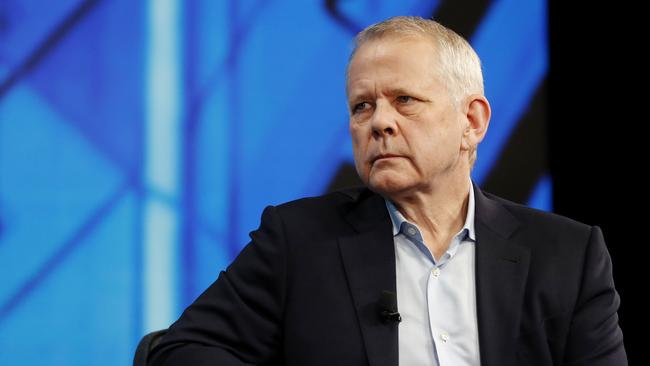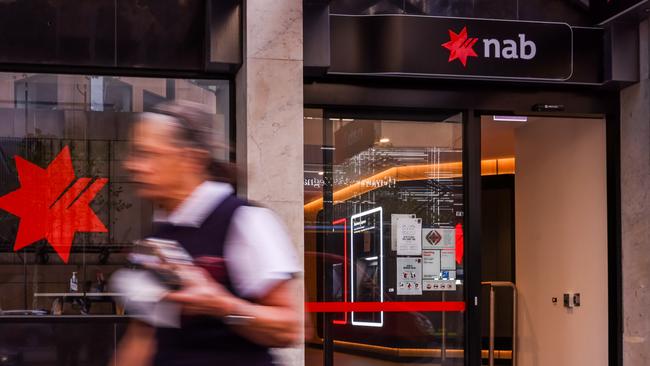
There are still years of work ahead of NAB chief executive Ross McEwan to get to the point of Clark’s conservative reign of the late 1980s, but investors are getting more and more confident over where he is taking the bank and its digital intent.
McEwan is being supported in his quest by NAB chairman Phil Chronican, who worked under David Morgan at Westpac before moving across to ANZ (where for a period he had McEwan as his direct competitor).
For more than two decades the bank had variously been called “Bad News NAB” after being embroiled in forex trading scandals, Irish bank heists and crippling exotic debt instrument exposures.
Some fund managers have been more savage, slamming the lender as the “Death Star” given its reputation for destroying investor funds under a string of successive CEOs.
Its shares were the perennial underperformers and at times NAB’s strongest franchise – small to mid-sized business lending – went unloved in a chase for higher returns elsewhere.
In two decades two CEOs have been forced out, one cut short his tenure and the other was left with a questionable US expansion. The bank took heavy reputational blows through the Hayne royal commission, prompting the exit of previous boss Andrew Thorburn and chairman Ken Henry.

Today McEwan and Chronican, two New Zealanders, bring experience and competence to their respective roles. And while this sounds a little too obvious, in a big bank it is sometimes all investors need.
McEwan, the former Commonwealth Bank executive who set out on a rescue mission of the UK’s wounded RBS in the aftermath of the Global Financial Crisis, started at NAB’s Melbourne HQ in December 2019 just as the pandemic was about to hit.
This means he has been working behind the scenes to rebuild NAB and its management team through a string of lockdowns, border closures and extraordinary pressures on the economy. He set out a plan in April last year of making NAB relationship-led, simple, seamless, decisive, safe and taking a long-term approach to managing its business.
Now he is moving from the promise stage into the delivery phase.
McEwan was talking as NAB delivered a 10.7 per cent lift in first-half profit to $3.55bn. Interim dividends were lifted sharply to 73c a share, from the lockdown-marred 67c in the September half last year. Overall revenue was up 4.6 per cent during the March half, while a release of some provisions helped lift the bottom line.
NAB secured fast-paced lending and deposit growth across all of its businesses – including growing small to mid-sized business lending at nearly twice the rate of the broader market.
In Australia, home lending increased by $13bn, which outpaced broader market growth.
Other metrics, including earnings per share and return on equity, are returning to pre-Covid levels, while the bank remains flush with cash. McEwan says his team is delivering a better result “because we’re getting the basics right more consistently”.
“And I need to be clear we have a lot more to do. It’s not complex. It’s about the basics, but it takes discipline, focus and good execution,” he says. “I’ve been delighted this was probably the first set of results I’ve ever been able to put out that had growth across every business but also every part of every business. It’s not just lending, it’s deposits, transaction accounts growing as well.”.
Big investors have already got on board. NAB has experienced the fastest share price growth over the past 12 months (up 21.6 per cent), easily outpacing its nearest rival Commonwealth Bank, which has gained 11.5 per cent.
Cost pressures
Even with the sale of the MLC wealth franchise and the return of $5bn in capital, NAB has overtaken both ANZ and Westpac, which has a bigger lending book, to now be the nation’s second- largest bank. Under Clark and then Don Argus, who followed, it was the biggest.
“Bad News NAB” is still on the fringes. This week the bank escaped a financial penalty, but was put on a tight leash by financial crimes regulator Austrac following some long-running lapses. It will require a substantial uplift in spending on anti-money-laundering controls and improving its customer risk assessments.
This will add to the bank’s cost pressures this year, taking cost growth to the top end of the range of 2-3 per cent. Meanwhile talks will soon begin with unions for a new workplace agreement that is expected to pile additional pressure to the cost line.
McEwan points out that, of the $1.4bn spent on investment this year, 50 per cent will be on essential regulatory and remediation spending. Last year it was 60 per cent. Next year regulatory spending will come down to 40 per cent of all investment spending, meaning there will be more to invest on technology and growth.

This includes work under way in building what McEwan describes as Australia’s simplest home loan platform, which he says will drive significant time savings for customers and bankers. Ultimately, the whole process of applying and having a loan approved will be done online, with intervention by a banker only by exception, McEwan says.
This is being rolled out for simple home loans with an eye to using the platform to more complicated loans, including business loans or agribusiness. It dramatically speeds up loan applications and gives customers greater control of the process.
With interest rates here and around the world rising sharply, McEwan admits this new phase of the world is unlike anything he has seen in his career. His customers will feel some pain from the rising cash rate, but NAB has been building in buffers on new home loans. On average, his customers are three to four years ahead on home loan repayments.
Despite inflation starting to bite, McEwan says Australia is in a strong position to handle rising interest rates.
Small to mid-sized businesses – which are key to NAB’s earnings – are yet to pull back on borrowing despite expectations of rapidly rising interest rates. Instead, it seems like customers are wanting to invest in growth to come, McEwan says. He says the biggest complaint from business customers is not borrowing costs but staff shortages, which threaten to inhibit growth.
Rising interest rates and the prospect of a slowing property market hasn’t changed NAB’s appetite to continue to push for mortgage market growth.
“I think it’s a great place to be because customers need a mortgage,” McEwan says. “So as long as we’re making a reasonable return out of it, we’ll be there.”
johnstone@theaustralian.com.au








It has taken a double act of two of the most experienced bankers in Australia to finally put National Australia Bank back on the path of when legendary chief executive Nobby Clark ran the best lender in the country.